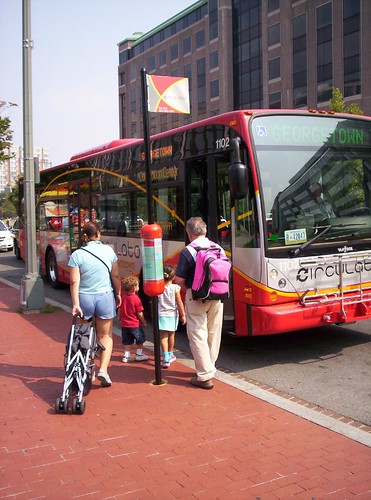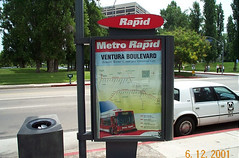Speaking of mobility...

The Downtown Circulator has added an around the National Mall "circle" route, according to the Post, in the article "Circulator Bus Service Heading Toward the Mall ." I will say that the ridership numbers are not impressive, although I do think that could be addressed by much more focused marketing. (In fact, the ridership numbers are pathetic.)
This would require a sea change in attitude, taking an almost direct or guerilla marketing orientation, focusing building-by-building along the routes to build ridership by residents working in buildings on the route, as well as developing a much better explanatory-wayfinding system of signage explaining what the Downtown Circulator is and how to use it.
As we learned with the Downtown open-air arts market this past holiday season, the Downtown DC BID doesn't believe in focused building-by-building marketing of downtown events (i.e., lobby-based placard marketing campaigns, including building receptions). See Shopping, With an Urban Appeal by Lori Montgomery for a Post take on that market (not focused on its marketing but the market in general).
I will say that the Downtown Circulator system has been doing some good guerilla marketing at street-based events such as at RFK Stadium in advance of baseball games, and at the Arts on Foot street festival in the Penn Quarter last year. (However the Circulator website has not yet been updated with a map for the third line.)
But signage that explains, rather than "pretty" image ads that brand the service but provide little actionable information, is necessary at least in the subway stations along the route, such as Union Station, Gallery Place, and Metro Center, and at key points, such as the Convention Center.
 A larger sign, along the lines of this example from Los Angeles, could be added to the signage in subway stations, explaining how the Circulator complements subway and other forms of transit. At Union Station, some sort of explanatory signage explaining the various ways of getting around: (1) subway; (2) bus including Circulator; (3) Tourmobile; (4) Old Town Trolley and competitors, needs to be created. It's unfair to visitors for so little information to be provided.
A larger sign, along the lines of this example from Los Angeles, could be added to the signage in subway stations, explaining how the Circulator complements subway and other forms of transit. At Union Station, some sort of explanatory signage explaining the various ways of getting around: (1) subway; (2) bus including Circulator; (3) Tourmobile; (4) Old Town Trolley and competitors, needs to be created. It's unfair to visitors for so little information to be provided.One of the things that this new Circulator line does is bump into the National Park Service, and it shows the "conflict of interest" between the NPS making money from concessionaires versus providing the best possible service. From the article:
The expanded bus service is not welcome news to Tom Mack, owner and board chairman of Tourmobile Sightseeing Inc., which has held exclusive rights to provide the sightseeing transportation on the Mall under agreements with the National Park Service dating to 1969. The average adult fare is $20 for the day.
The new route, he said, has the potential to damage -- and possibly destroy -- his business. Last year, Tourmobile served more than 1 million people at all of its sites, including Arlington National Cemetery and the major memorials. "I believe this is an intentional infringement upon my contract," he said.
"We certainly wouldn't agree with that statement," said Alexa Viets, a National Park Service transportation planner for the Mall. "We view this as an extension of the existing public transportation network. We believe it complements the interpretative visitor transit service provided by the Tourmobile national concession."
I have written before that the fact that NPS earnings from concessions go to local improvements. Given the continued downward pressure on NPS budgets, my sense is that NPS prefers to protect this relationship. Note that NPS has an ongoing visitor transportation study for the National Capital Parks.
The press release for the new route mentions some changes in the overall service.
Index Keywords: transit



0 Comments:
Post a Comment
<< Home